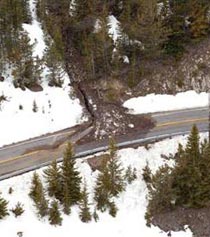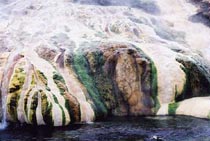| (insert your NIE or newspaper logo here) | Weekly Online LessonOnline Lesson ArchiveGrade Level: 5-8
|
National Parks Highlight
Nature's Wonders
 Towns surrounding national parks look forward to big boosts in revenue
when school schedules yield to summer vacation plans.
Towns surrounding national parks look forward to big boosts in revenue
when school schedules yield to summer vacation plans.
But a few of towns near Yellowstone National Park may not see as many tourists as usual this season, due to some recent road closures caused by Mother Nature.
On May 19 and 20, 2005, five major landslides poured about 500 million tons of mud and rock onto U.S. Highway 212 in 13 places between Red Lodge and Cooke City, Montana.
On Tuesday, June 7, work crews announced they had finally cleared the first of the five slides.
But even with the first one cleared, the slides have shut down over half of the 68-mile Beartooth Highway, which leads from eastern Montana to Yellowstone's northeast entrance. Clearing and repairing the road will take an estimated $20 million and be completed, if they're lucky, by mid-October.
The winding, scenic byway is a frequent favorite of summer tourists - driven by about 900 cars daily - on their way to Yellowstone, because of the stunning and unique landscapes it provides. Towns along and near the route - including Red Lodge, Montana, and Cody, Wyoming - reap the benefits from this seasonal traffic boom, through gasoline, food, lodging, and merchandise sales.
Fortunately, although the first two dozen miles of the the Beartooth Highway are closed, tourists can use the Chief Joseph Scenic Highway as a detour to the western half of Beartooth then enter Yellowstone at the northeast entrance.
Human-made amusement parks also see lots of summer tourists, but the natural beauty and wonders found in national parks will always draw their fair share of sightseers and outdoor enthusiasts - no matter what detour they might face to get there.
During this week's lesson, you'll skip the driving detour and explore Yellowstone National Park's natural attractions through electronic field trips. You'll also get a chance to locate other national parks, and compare their natural wonders and locations.
Yellowstone In-Depth
 Early American explorers and scientists were struck with awe over
the area's geysers and other natural features.
Early American explorers and scientists were struck with awe over
the area's geysers and other natural features.
So much so, that on March 1, 1872, President Ulysses Grant signed into existence the world's first national park: Yellowstone National Park. The 2.2 million acres of wilderness in the area was "set apart as a public park or pleasuring ground for the benefit and enjoyment of the people."
Since then, not only has the park seen increasingly more tourists, it's also seen more scientists, fascinated by the dynamic, natural processes that happen there.
Start investigating what scientists have been learning about the Yellowstone region by joining a few electronic field trips at the park's Windows Into Wonderlands visitor's center.
Begin your journey with Geyser Quest, to learn more about one of the park's most popular attractions, Old Faithful.
What are the three necessary ingredients for a geyser? What geological factors unique to the area contribute to these ingredients? How have the different geysers changed since the region became a park, and what factors influenced these changes? In what ways has the area remained the same?
 To explore more in-depth discoveries about how Yellowstone's
geology influences its natural wonders, go On
the Scene at the Yellowstone Hotspot to find out why Yellowstone
Lake's water levels have shifted.
To explore more in-depth discoveries about how Yellowstone's
geology influences its natural wonders, go On
the Scene at the Yellowstone Hotspot to find out why Yellowstone
Lake's water levels have shifted.
What changes in the landscape did scientists notice? What factors influenced these changes? What evidence did scientists find that helped them solve the mystery?
As you'll soon learn through Hot Colors - Windows Into Hidden Worlds, these unique waters aren't void of life - they are teeming with it!
What are some examples of microbes that live in Yellowstone's thermal springs? What roles do microbes play in an ecosystem? What are some of the unique environmental conditions in which these microbes live? What's the difference between acidic and alkaline? What are some of the other life forms that are dependent upon the hot springs?
 Now, let's get out of the water and onto the land.
Now, let's get out of the water and onto the land.
To get an overview of the area, join a team of aliens Zooming In On Hayden Valley.
How did geological changes affect the region's natural features, including soil composition, over time? How have these factors created the area's different habitats? What types of animals live in these areas and how do they survive there?
Next, either discover what it's like To Eat Or Be Eaten in Hayden Valley or learn about The Wolves of Yellowstone: Legacy, Legend, and Recovery.
(Browse both field trips, and any of the others listed on the Windows Into Wonderlands index page, if you have time.)
How do the survival strategies of the different species of animals compare with one another? In what ways do the animals interact? In what ways do the decisions or actions by humans impact the lives of these species, either by affecting habitat or animal species?
Beyond Yellowstone
 While
Yellowstone is the nation's oldest park, it's certainly not the only
natural gem that Americans treasure.
While
Yellowstone is the nation's oldest park, it's certainly not the only
natural gem that Americans treasure.
To explore other parks - whether in your own state or in another, spend some time with the National Park Service.
At this site, you can explore Parks & Recreation areas by name, location, or topic.
Each park's page gives you an overview of the area, activities you can do there, in-depth information, and it may also offer related pages on Nature & Science or History & Culture.
From the home page, you can also dive into the Nature & Science section, which explains some of the natural resource issues and topics that park managers must deal address. Management decisions relate to Air, Biology, Geology, Natural Sounds, and Water dynamics.
If you plan to visit a national, state, or other public park this summer, take some time to learn more about the park's natural attractions and ecosystems, geological history, and other background information. Go online to hook a few basics, then prepare a list of mysteries to solve while on your field trip.
For example, what types of forces helped to shape the larger landscape? What kinds of plants, animals, and microbes live there? What kinds of habitats do they use, and what do they eat there? Has the land ever been used by humans, and, if so, for what purposes? How have those activities affected the area's natural characteristics?
While you're out, draw some pictures or write a story about what you see.
If you aren't able to get to a park this summer, spend some time on more electronic field trips to compare park features in different regions of the country. You could even collect photos of the different places and make a public park collage!
Newspaper Activities
In current issues of The Salt Lake Tribune, find any news or feature stories about a national or state park. What kinds of natural attractions or recreation activities does the park offer? Does the reporter explain any geologic or human history related to the park? What kinds of flora and fauna exist in the park? What kinds of natural water features does the park have? What roads lead in to the park? How much of the park can be accessed by car and how much on foot, bike, horse, or climbing gear? In what ways do towns or neighborhoods try to attract tourist dollars? How does this park compare to others nearby, or near another city, or in another state?
© Copyright 2005
Learners Online, Inc.
